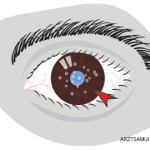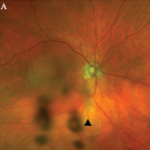Other diseases that cause both uveitis and arthritis include Whipple’s disease, relapsing polychondritis, neonatal onset multisystem inflammatory disease, and Kawasaki’s disease.
Medical Treatment of Immune-mediated Uveitis
Most experts in the treatment of uveitis rely on a pyramidal approach to the inflammation. The levels in the pyramid as used in our practice are:
Topical corticosteroids: Topical corticosteroid therapy, such as prednisolone acetate, is used to treat anterior uveitis. Initial administration is usually frequent, with gradual tapering when inflammation subsides. The major side effects include increased intraocular pressure and cataractogenesis.
Topical cycloplegics: Cycloplegics help relieve photophobia and pain, secondary to ciliary spasm. They prevent or sometimes break synechiae formation. They are usually used in active anterior uveitis. Some of the options to dilate the pupil include cyclopentolate, scopolamine, and atropine. While these are usually well tolerated, cycloplegics should be used with caution in children and elderly patients. Potential but rare systemic side effects include fever, tachycardia, seizure, and hallucinations. Patients with a dilated pupil have difficulty with near vision such as reading and may be especially sensitive to sun.
Local corticosteroids injection and intraocular sustained released implant: Periocular corticosteroid injections are useful in acute, recalcitrant, or noncompliant cases as an alternative to frequent eye drops. They are also particularly helpful when posterior segment involvement such as macular edema occurs. Periocular injection is effective 70% of the time, but intravitreal injection is an alternative if the clinical benefit proves inadequate. Use intravitreal triamcinolone acetonide injection to treat macular edema from uveitis. Surgical implantation of a sustained-released device is an option for chronic persistent inflammation. A fluocinolone implant is Food and Drug Administration (FDA)–ap-proved and delivers corticosteroid into the vitreous cavity for 30 months. The main adverse effects are similar to those of topical corticosteroid treatment, but one more common and severe.
Systemic corticosteroids and immunosuppressive agents: Oral corticosteroids are the mainstay of uveitis therapy. For the patient whose condition is not adequately controlled by topical corticosteroids or local therapy, immunosuppression may be required to combat vision-threatening inflammation, inadequate response to corticosteroid treatment, and corticosteroid intolerance. Drugs options include antimetabolites (i.e., methotrexate, azathioprine, and mycophenolate mofetil), calcineurin inhibitors (i.e., cyclosporine and tacrolimus), and alkylating agents (cyclophosphamide and chlorambucil).22
Biologics: TNF inhibitors, alpha interferon, and daclizumab (anti–IL-2 receptor alpha chain) have been studied for the treatment of uveitis. Of the TNF inhibitors, infliximab has proven dramatically effective for several manifestations of Behçet’s disease, and some argue that it is the drug of choice for this indication.23 On the basis of retrospective data, several centers have concluded that infliximab is more effective than etanercept in the treatment of uveitis.24



